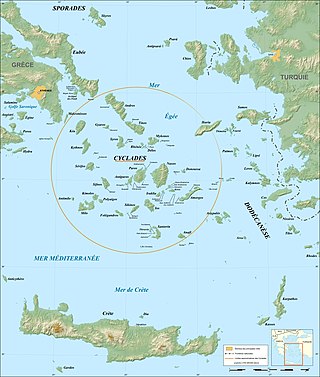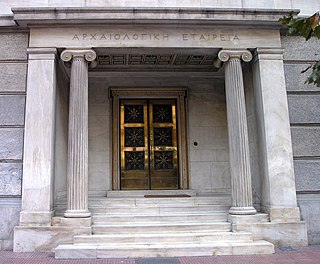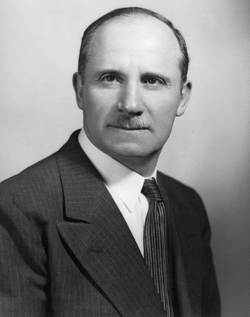
Classics or classical studies is the study of classical antiquity. In the Western world, classics traditionally refers to the study of Classical Greek and Roman literature and their related original languages, Ancient Greek and Latin. Classics also includes Greco-Roman philosophy, history, archaeology, anthropology, art, mythology and society as secondary subjects.

The Parthenon is a former temple on the Athenian Acropolis, Greece, that was dedicated to the goddess Athena during the fifth century BC. Its decorative sculptures are considered some of the high points of classical Greek art, an enduring symbol of Ancient Greece, democracy, and Western civilization.

Cycladic culture was a Bronze Age culture found throughout the islands of the Cyclades in the Aegean Sea. In chronological terms, it is a relative dating system for artifacts which serves as a roughly contemporary dating system to Helladic chronology and Minoan chronology (Crete) during the same period of time.
Archaeology is the study of human activity in the past, primarily through the recovery and analysis of the material culture and environmental data that they have left behind, which includes artifacts, architecture, biofacts and cultural landscapes.
Areas of archaeological potential, also known as areas of high archaeological potential or urban archaeological zones, are locations within a country identified by archeologists as sites where buried archaeological artifacts are likely to survive. There are hundreds of thousands of areas of archaeological potential worldwide, yet many factors limit the excavation of them. There is a multitude of factors that contribute to these areas of archeological potential, mainly the environmental factors, but also political factors, and the history that the country holds.

The Archaeological Society of Athens is an independent learned society. Also termed the Greek Archaeological Society, it was founded in 1837 by Konstantinos Bellios, just a few years after the establishment of the modern Greek State, with the aim of encouraging archaeological excavations, maintenance, care and exhibition of antiquities in Greece.

George Emmanuel Mylonas was a Greek archaeologist of ancient Greece and Aegean prehistory. He is known for his numerous excavations, particularly at Olynthus, Eleusis and at Mycenae, where he made the first archaeological study and publication of Grave Circle B, the earliest known monumentalized burials at the site.

Akanthos was an ancient Greek city on the Athos peninsula, on the narrow neck of land between the sacred mountain and the mainland, to the northwest of the Xerxes Canal. It was founded in the 7th century BCE as a colony of Andros, itself a colony of Chalcis in Euboea. Chalcidice was multi-cultural. The archaeology of the region suggests that some Hellenes were already there. The site is on the north-east side of Akti, on the most eastern peninsula of Chalcidice.
The antiquities trade is the exchange of antiquities and archaeological artifacts from around the world. This trade may be illicit or completely legal. The legal antiquities trade abides by national regulations, allowing for extraction of artifacts for scientific study whilst maintaining archaeological and anthropological context. The illicit antiquities trade involves non-scientific extraction that ignores the archaeological and anthropological context from the artifacts.

Heroic nudity or ideal nudity is a concept in classical scholarship to describe the un-realist use of nudity in classical sculpture to show figures who may be heroes, deities, or semi-divine beings. This convention began in Archaic and Classical Greece and continued in Hellenistic and Roman sculpture. The existence or place of the convention is the subject of scholarly argument.

Archaeology or archeology is the study of human activity through the recovery and analysis of material culture. The archaeological record consists of artifacts, architecture, biofacts or ecofacts, sites, and cultural landscapes. Archaeology can be considered both a social science and a branch of the humanities. It is usually considered an independent academic discipline, but may also be classified as part of anthropology, history or geography.

Gordion was the capital city of ancient Phrygia. It was located at the site of modern Yassıhüyük, about 70–80 km (43–50 mi) southwest of Ankara, in the immediate vicinity of Polatlı district. Gordion's location at the confluence of the Sakarya and Porsuk rivers gave it a strategic location with control over fertile land. Gordion lies where the ancient road between Lydia and Assyria/Babylonia crossed the Sangarius river. Occupation at the site is attested from the Early Bronze Age continuously until the 4th century CE and again in the 13th and 14th centuries CE. The Citadel Mound at Gordion is approximately 13.5 hectares in size, and at its height habitation extended beyond this in an area approximately 100 hectares in size. Gordion is the type site of Phrygian civilization, and its well-preserved destruction level of c. 800 BCE is a chronological linchpin in the region. The long tradition of tumuli at the site is an important record of elite monumentality and burial practice during the Iron Age.

Charles Martin Robertson, known as Martin Robertson, was a British classical scholar and poet. He specialised in the art and archaeology of Ancient Greece, and was best known for his 1975 publication, A History of Greek Art.
John Peter Oleson is a Canadian classical archaeologist and historian of ancient technology. His main interests are the Roman Near East, maritime archaeology, and ancient technology, especially hydraulic technology, water-lifting devices, and Roman concrete construction.
Andrew Ian Wilson is a British classical archaeologist and Head of School of Archaeology at the University of Oxford. He was director of the Oxford Institute of Archaeology from 2009 to 2011. Wilson's main research interests are the economy of the Roman world, Greek and Roman water supply, and ancient technology.

Tarsus Museum is an archaeology and ethnography museum in Tarsus, Mersin Province, in southern Turkey.

Archaeological looting is the illicit removal of artifacts from an archaeological site. Such looting is the major source of artifacts for the antiquities market. Looting typically involves either the illegal exportation of artifacts from their country of origin or the domestic distribution of looted goods. Looting has been linked to the economic and political stability of the possessing nation, with levels of looting increasing during times of crisis, but it has been known to occur during peacetimes and some looters take part in the practice as a means of income, referred to as subsistence looting. However, looting is also endemic in so-called "archaeological countries" like Italy, Greece, Turkey, Cyprus and other areas of the Mediterranean Basin, as well as many areas of Africa, South East Asia and Central and South America, which have a rich heritage of archaeological sites, a large proportion of which are still unknown to formal archaeological science. Many countries have antique looting laws which state that the removal of the cultural object without formal permission is illegal and considered theft. Looting is not only illegal; the practice may also threaten access to cultural heritage. Cultural heritage is knowledge about a heritage that is passed down from generation to generation.

In archaeological terms, graffiti is a mark, image or writing scratched or engraved into a surface. There have been numerous examples found on sites of the Roman Empire, including taverns and houses, as well as on pottery of the time. In many cases the graffiti tend toward the rude, with a line etched into the basilica in Pompeii reading "Lucilla made money from her body," phallic images, as well as erotic pictures. Other graffiti took on a more innocent nature, taking the form of simple pictures or games. Although many forms of Roman graffiti are indecipherable, studying the graffiti left behind from the Roman Period can give a better understanding of the daily life and attitudes of the Roman people with conclusions drawn about how everyday Romans talked, where they spent their time, and their interactions within those spaces.

Barbara Tsakirgis was an American classical archaeologist with specialization in Greek and Roman archaeology, particularly of ancient Greek houses and households. She worked in the archaeological excavation sites in Sicily and Athens for her doctoral thesis from Princeton University on the subject of Hellenistic houses at Morgantina. Her thesis was published as The Domestic Architecture of Morgantina in the Hellenistic and Roman Periods (1984). She taught at the Vanderbilt University's Department of Classical Studies and was an associate professor from 1992 to 2019.

Anna Marguerite McCann was an American art historian and archaeologist. She is known for being an early influencer—and the first American woman—in the field of underwater archaeology, beginning in the 1960s. McCann authored works pertaining to Roman art and Classical archaeology, and taught both art history and archaeology at various universities in the United States. McCann was an active member of the Archaeological Institute of America, and received its Gold Medal Award in 1998. She also published under the name Anna McCann Taggart.














